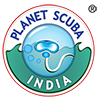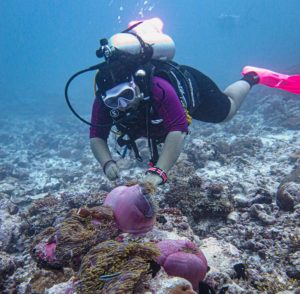Introducing the manufacture of scuba diving equipment for the first time in the country
Bengaluru, India – September 8, 2022: The Defence Bioengineering and Electromedical Laboratory (DEBEL), a
unit of Defence Research and Development Organisation (DRDO), on Thursday, flagged off India’s first‐ever
venture to manufacture scuba diving equipment in the country.
The initiative is being spearheaded by Planet Scuba India (PSI), one of the country’s foremost scuba diving
companies, and a forerunner in bringing innovation to the diving industry in India. To drive the Government of
India’s #MakeInIndia initiative, it has introduced Taiwanese design house CREST Diving for the development of
state‐of‐the‐art scuba diving equipment in India.
Scuba diving equipment manufacture is a multi‐billion‐dollar global industry requiring high‐precision
engineering skills to create underwater breathing and survival systems that can survive the rigours of deep
oceans to fast‐flowing rivers and lakes. The major global brands are based in Europe and the US. China
manufactures lower‐end products like masks, fins, snorkels and wetsuits. Higher‐end products requiring
precision engineering and quality such as critical breathing systems are mostly designed and manufactured in
Taiwan.
India, despite its military prowess, and over 7,500 kms of coastline, has no manufacturing capability in this
sector. We are 100 percent import‐dependent, spending nearly $100 million a year. The country already has the
necessary infrastructure – from precision metal‐shaping and mould‐making to manufacturing various grades of
plastics and associated polymer products – thanks to the efforts of DRDO and India’s space programme.
Planet Scuba India, an early starter in the country’s diving industry, having begun operations in 2008, has been
importing and distributing diving equipment for the last 14 years. Now, encouraged by DEBEL and military divers,
PSI’s two‐pronged approach aims to not only help bring some of the best scuba diving technology to our shores,
but also to provide the world an alternative to China for the manufacture of dive equipment. The objective is to
create an end‐to‐end dive equipment manufacturing eco‐system in the country. To this end, PSI hasroped CREST
Diving into designing and manufacturing of some of its high‐end products in India.
“We laud this effort to bring manufacturing of diving equipment to India. It is a great step towards the
government’s Atmanirbhar Bharat or Make in India initiative. DEBEL has already made greatstridesin developing
several underwater breathing and survival products for the military, and will support all such ventures that lead
to indigenisation of technology and products,” said DEBEL’s Joint Director, Dr R Indu Shekar at the launch event
in the city.
“The Make In India initiative and the world’s need for an alternative to China have come together to give us a
geo‐strategic opportunity. This is our contribution to our passion for diving and the oceans,” said PSI’s Managing
Director, Madhava Reddy, adding that, “With help from Taiwan and CREST Diving, we will help bring India up‐
to‐ speed on existing technologies in diving, and then with help from Indian research agencies like DEBEL, create
new products both for India and the world. We will do our best to create an eco‐system in the country for the
manufacture of underwater breathing equipment.”
Scuba diving for Fit India & other health benefits
When most people think about scuba diving, they picture vibrant coral reefs, sea turtles and fascinating marine life. And though, these are definite reasons to go scuba diving, they are not all that diving has to offer. Did you know that scuba diving has a multitude of positive health benefits? Yes, we are talking of scuba diving for Fit India! Some of the scuba diving health benefits are derived from the physical activity it entails. But there are also proven mental health benefits. In fact, you might be surprised to learn just how far reaching the effects of scuba diving are on both your physical and mental well-being.
Scuba Dive for Fit India & A Healthier You
Here are just a few key benefits you experience when you go scuba diving in India:
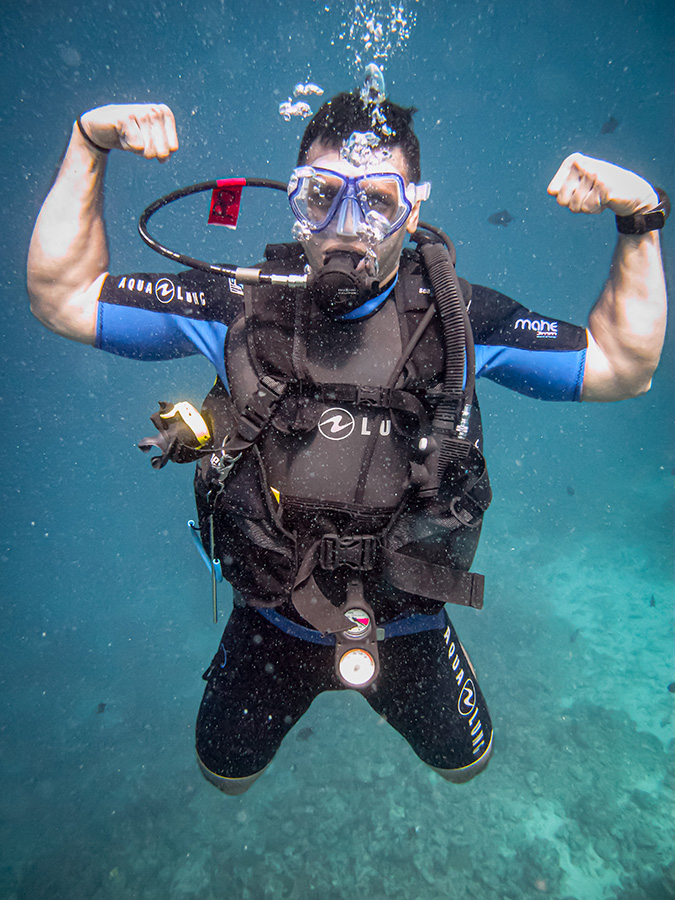 1. It improves your breathing and respiratory system.
1. It improves your breathing and respiratory system.
Scuba diving encourages divers to take long, slow, deep breathes. A calm, slow breathing pattern reduces the risk of a lung-expansion injury while diving. But did you know that it also helps reduce mucus build up?! This breathing pattern has also been known to help with existing conditions, such as asthma. The breathing technique used during diving is similar to that used during some styles of meditation, including yoga. It helps slow down your heart rate, promoting a state of peacefulness. Slow rhythmic breathing can also have a calming effect on your psyche.
2. It increases your fitness levels, strength and flexibility.
Have you heard of resistance training? When you go scuba diving, you’ll be doing that too! Your muscles have to work harder underwater than they would on land due to the increased resistance caused by the water around you. The level of resistance increases significantly when you are swimming against even a mild current. That’s why we recommend scuba diving for Fit India. The more you dive and swim, the more your muscles begin to strengthen. And you’ll also develop endurance as well as flexibility. Scuba diving and swimming doesn’t only give your legs a workout. It can also help build up your core strength, which is important for a good overall posture.
3. It lowers your blood pressure
Remember the first time you went underwater? In all likelihood, you would have experienced a spike in blood pressure. Most divers do, due to the excitement and adrenaline. But this is usually only a temporary increase. Once you have recovered from the initial spike, your heart rate reduces, so does your blood pressure. The slow and deep breathing technique you learn helps lower your blood pressure and keeps you calm throughout the dive.
4. It introduces you to the spectacular marine life underwater
Seeing stunning coral reefs and a fabulous array of fish and critters is enough to put anyone in a good mood. Also, it has been proven that seeing certain colors can affect the brain in many different ways. Scientists believe that being subjected to bright, intense colors, similar to the ones we might find surrounding reefs, can promote feelings of happiness. It can uplift your mood. In addition, the color blue has been known to induce a calming effect on the body.
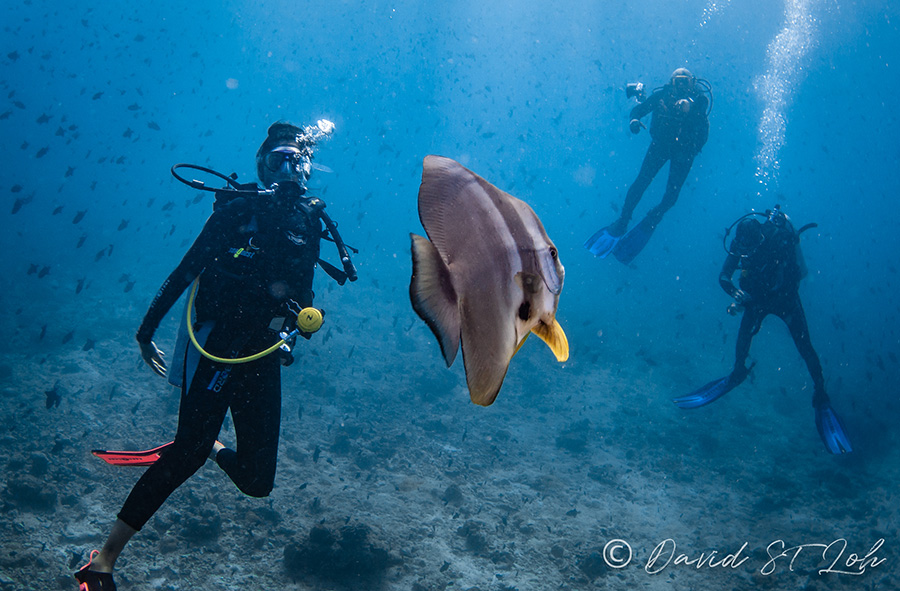 5. It encourages you to travel around the world on an adventure
5. It encourages you to travel around the world on an adventure
Yes, it is possible to dive virtually anywhere on the planet that has a body of water. However, divers tend to travel more than they dive at home. Traveling overseas, exploring and taking time off work, all lead to adventures, excitement and positive experiences. All of which are good for your body, mind and soul. Infinitely much better than being stressed, bored and stuck in a rut, don’t you agree?!
6. It provides you with the healing effects of water
Being underwater has many healing benefits. The likeness to being in the womb is believed to promote feelings of security, well-being and happiness. In addition, being in salt water for long periods of time can cause your body to dehydrate meaning that you tend to drink a lot more after the dive. This in turn means that you are replenishing your cells. You are receiving all the benefits of water both externally and internally.
7. It exposes you to sunlight
Being exposed to sunlight creates vitamin D. Vitamin D helps the absorption of calcium, which in turn keeps bones healthy and strong. Exposure to sunlight also helps increase endorphin production. Now you know why we scuba divers are a happy lot.
8. It has socializing benefits
Diving is a social activity. It involves diving with a buddy. And among divers, we find like-minded people with a common interest. There is a sense of community. A sense of being part of a ‘tribe’ when spending time with other divers. All of which are positive feelings and good for your mental well-being. Did we mention that it also helps lower stress, building confidence and gives you a sense of security and belonging!
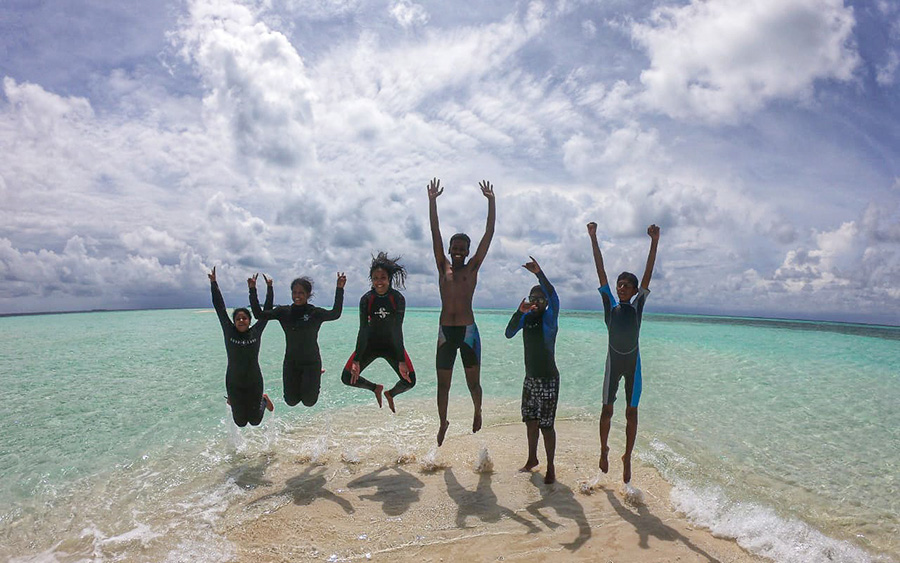 9. It is a great stress reliever
9. It is a great stress reliever
We have mentioned it earlier that the breathing pattern for diving is similar to a meditative breathing pattern. Meditating is a great remedy for stress too. Slower breathing promotes calmness. Not just that, but when we are diving, we are focused on the environment around us which enables us to completely forget work, family, relationships or financial issues. Having this mental ‘time out’ gives the body a chance to rest. It brings the nervous system back to its natural balance. Studies have shown that a relaxed and calm mind promotes a positive mental attitude. It helps you deal with your issues in a calm and rational manner. It reduces feelings of depression.
Corona Virus & Fitness
There are many uncertainties and unknowns surrounding the Corona Virus pandemic. But one thing that is widely believed to be true is that the effects of COVID-19 are generally less severe in a person who is physically healthy and fit. We know, you may not cherish the thought of going to the gym to work on your fitness, but how about going diving instead!
Scuba Diving in India
At Plant Scuba India, we are following recommendations regarding scuba diving health and hygiene standards. We have new procedures in place to ensure that gear is disinfected and all recommendations are being met. If you have tested positive for COVID-19, you will require a doctors medical clearance, as a precautionary measure, prior to participating in any in-water activities. Contact us by email and we can provide you with a form for your doctor to sign.
If you’d like to learn to dive or to join us for fun diving in India, or if you have any questions about scuba diving for Fit India, health and diving, or corona virus and diving, contact us on: holidays@planetscubaindia.com.
We look forward to diving with you soon!
Text: Sarah Ann Wormland, PADI
Photos (in order of appearance): Madhava Reddy, David ST Loh, Gopala Krishnan
India scuba diving & other fascinating facts
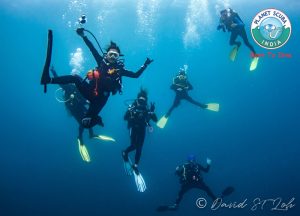
Scuba diving in India is still at a nascent stage. This is mostly because only a small percentage of Indians have taken that giant leap and joined the dive club. That said, most non-divers are as intrigued by the underwater world. As a scuba diver, you have definitely been asked some, or most, of these questions: What does scuba mean? Do you breathe oxygen underwater? Are corals as colorful in reality as they are in pictures? Have they really found the lost city of Dwarka, and can you dive there?
You can find the answer to all these questions here, along with some more fun facts about scuba diving in India. Also we have interesting tidbits about diving in general, which you may not have known.
Scuba is an acronym.
It stands for ‘self-contained underwater breathing apparatus’.
In 1943, the first scuba gear was invented.
By Jacques Cousteau. It was called Aqua Lung. Currently, one of the top scuba diving equipment companies in the world.
Divers breathe compressed air underwater.
No, not oxygen. In fact, breathing oxygen under pressure is toxic. The scuba diving cylinder contains the normal air you breathe on land, which is 79% nitrogen and 21% oxygen.
Colors fade underwater.
This is because water absorbs light. Water absorbs different wavelengths of light to different degrees. The first to fade is red. Next to follow is orange, then yellow… This is why your blood looks greenish-black underwater. It is also why corals don’t appear as colorful as they are in pictures. Well, until you point the light from your dive torch at them.
Only 5% of the oceans have been explored.
The final frontier is not just space, but also our own oceans. Approximately 95% of the world’s oceans still remains a mystery to us.
The Challenger Deep in the Mariana Trench is the deepest point in the ocean.
It is about 10,944 metres below sea level. No chance of scuba diving there. But it was first explored in 1960 by Jacques Piccard and Don Walsh.
The world’s deepest scuba dive is at 332.35 metres.
Or 1,090 feet and 4.5 inches to be exact. Ahmed Gabr broke the Guinness World Record for the deepest scuba dive in 2014. Then 41-year-old, he set this world record in the Red Sea, off the coast of Dahab, Egypt.
For scuba diving in India, only a fraction of our 7,500-kilometre coastline has been explored.
The Andamans and Lakshadweep are two of the best-known destinations for scuba diving in India. But there’s also good diving in Goa, Netrani, Pondicherry, Chennai, Rameshwaram…
Scuba diving in India at Dwarka has been on every avid diver’s bucket list.
Ever since marine scientists discovered archaeological remains underwater, off the Gulf of Khambhat, on the west coast of India. Rumor has it that the discovery might change history as we know it. And that the remains lying underwater here are allegedly 9,000 years old.
You can begin your scuba training at age 10.
The PADI Junior Open Water Diver certification allows young divers to dive with a PADI professional or certified parent or guardian to the depth of 12 metres.
Scuba diving in India | Myths vs. Facts
Myths that are preventing people from learning scuba diving in India. From fear of shark attacks to having to travel to international waters. We debunk the top five diving myths.
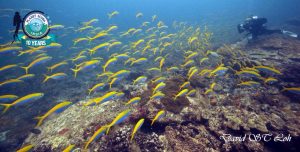
#1: You have to travel to international waters to scuba dive
There are some great sites for scuba diving in India. In fact, for some time now, scuba diving has been available right at your doorstep. For city dwellers, inland dive centers in India are a dream come true. You can complete the theory and confined water sessions of the PADI Open Water Diver Course in your city, over a weekend. (No point being stuck in a classroom on your holiday.) And then head out to the sea to complete your open water dives. Scuba diving in India is available at Goa, Andaman Islands, Lakshadweep, Netrani, Gujarat, Chennai, Pondicherry, Kerala and Kovalam. With new dive centres are opening up in different places across the country.
#2: You need to be an Olympic-level swimmer to scuba dive
You need to have basic swimming skills to learn scuba diving. The PADI Open Water Diver Course needs you to swim 200 meters without stopping. But it’s not a race. There is no time limit. The swim and 10 minutes of floating or treading water is just so that your instructor knows you are comfortable in the water.
Still have apprehensions about scuba diving? Ask your dive center about the PADI Discover Scuba Diving experience, before you take the plunge.
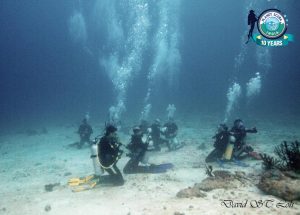
#3: You have to shell out a lot of money for diving gear
While scuba diving is a sport that needs equipment, it doesn’t mean to have to rush out and buy it. Most centers for scuba diving in India and internationally rent out gear. To begin with, you should start with the three basic items: mask, snorkel and fins. Wetsuits are the next on the to-buy list. Start buying gear only once you’re sure you are going to be diving regularly. Besides, renting gear initially will give you a good idea of which brand you should invest in.
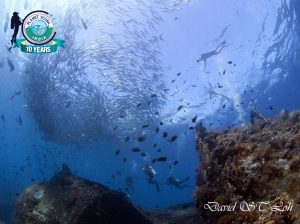
#4: Snorkeling gives you the same experience as scuba diving
We love snorkeling, especially when there are whale sharks or mantas close to the water’s surface. But nothing compares to the immersive experience that scuba diving gives. Why squint at the colorful reef way down below, when you can strap on your diving gear and descend for a closer look. Besides all that swimming on the surface is bound to tire you out. You can stay down much longer and explore more of the ocean when you scuba dive. Think turtles hiding below overhangs. Pygmy seahorses clinging to soft corals. Moray eels peeking out of reefs.
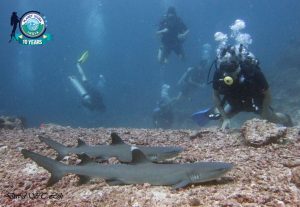
#5: You will get attacked by a shark
The theme song of Jaws hums in the heads of those who have developed a fear of sharks. It is the one of the main reasons why people are apprehensive about scuba diving in India, or anywhere else in the world for that matter. But as most divers will tell you, sharks are the most amazing creatures to see up close. In fact, you should count your lucky stars if you see one during a dive. Sharks are not in the least bit interested in divers. It’s just Bollywood and Hollywood fantastical blockbusters which have given them a bad rep.
Best Scuba diving in India: the top dive sites
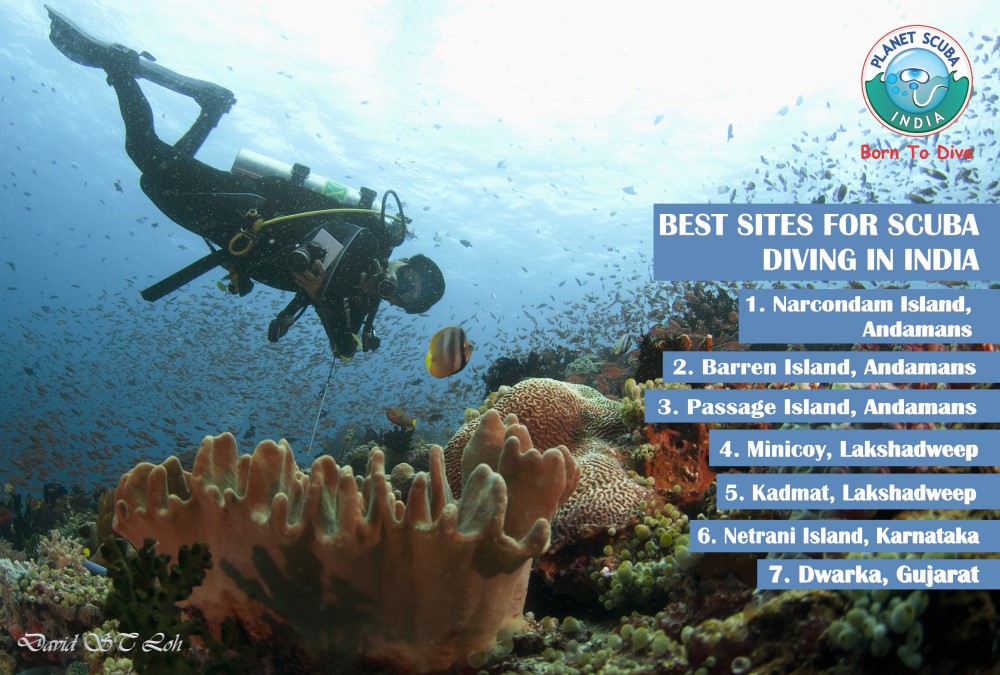
Here are seven of the best sites for scuba diving in India Planet Scuba India recommends that should be on your bucket list this year. Scuba diving in India has explored less than one per cent of the country’s more than 8,000 km coastline. By virtue of their geography, the archipelagos of Lakshadweep and Andaman and Nicobar are the gems of world class diving. Followed close on their heels by Dwarka. The lost city of legend that could well rewrite history as we know it! And then, there is the heart-shaped island in Karnataka. Adored by divers for its tranquil waters and rich marine life. From whale shark sightings to macro photography, scuba diving in India offers a plethora of options, for both beginners as well as advanced divers.
1. Narcondam Island, Andamans
Ooh La La—a quirky name for a site for scuba diving in India. But then, everything about Narcondam prompts the expression. Located around 256 km to the northeast of Port Blair, this volcanic island in the Andamans is covered in dense forests. Its lush green peak that rises from brilliant blue waters forms a rather picturesque contrast. But it is the panorama below the waves that interests scuba diving enthusiasts. Especially since it was none other than the father of scuba diving, Jacques Cousteau, who put this island on the diving map.
Scuba diving sites: Ooh La La and Lighthouse Reef. These scuba diving sites at Narcondam feature rocky ledges and steep slopes. These are replete with colorful hard and soft coral, huge barrel sponges and large sea fans. The clear waters offer visibility of up to 25 meters. Depths here exceed 30 meters.
Marine attractions: Schools of bumphead parrotfish, surgeonfish, fusiliers, snappers, angelfish and a variety of brightly hued reef fish. The deep waters also increase sightings of pelagics. Yes, one can expect to see manta rays, eagle rays, Napoleon wrasses, tunas, big-eyed travellies and grey reef and whitetip sharks.
2. Barren Island, Andamans
Scuba diving near an active volcano! The mere thought is enough to give you an adrenaline rush. Now couple that with the fact that the volcano dates back 1.6 million years. Packed your diving gear yet?! Barren Island in the Andamans lies on the edge of the India-Burma tectonic plates. And has earned a reputation worldwide for having some of the best sites for scuba diving in India. The underwater world here is a series of juxtapositions: clear blue waters, dark black soil and colorful reef life. Not to forget that surface intervals offer splendid sights of a smoking volcano.
Scuba diving sites: Purple Haze. Thus named to reflect a 50-meter-wide area covered in soft purple corals. Black Magic has sand divers and moray eels peeking out of a bed of black sand. Other scuba diving sites here include Manta Point, Coral Garden, Auditorium & Gallery and Manta Bay. You can spot that manta ray circling 25 meters away. Most dive sites have depths of more than 30 meters.
Marine attractions: Manta rays! Yes, we know we mentioned them already. Moray eels, turtles, octopus, whitetip and blacktip sharks. Also, barracudas, travellies, dogtooth tuna, needlefish, parrotfish, and a multitude of reef fish. Oh, and whale sharks are occasionally spotted at some of the dive sites here too.
3. Passage Island, Andamans
High on our list of best sites for scuba diving in India is the uninhabited Passage Island. Here the waters attract pelagics aplenty! Located about 53 km south of Port Blair, this island boasts an offshore pinnacle called Fish Rock. A scuba diving site that, true to its name, is teeming with fish life.
Scuba diving sites: Barrel sponges, large orange fan corals and clusters of soft corals cling to the rocky reef of Fish Rock. This dive site slopes down to more than 30 meters.
Marine attractions: Bumphead parrotfish crunch on corals. While barracudas and surgeonfish swirl around in schools. Yellowback fusiliers, bluestripe snappers and bannerfish paint the waters in their vibrant hues. Moray eels peek out from under rocks. The bolder ones, at times, can be seen draping themselves on fan corals. Also making an appearance are groupers, turtles, rays, Napoleon wrasses and dogtooth tuna.
4. Minicoy, Lakshadweep
Every diver we know of gets all dreamy-eyed about scuba diving in the Maldives. Enter Minicoy, the island located at the southernmost tip of the Lakshadweep archipelago. Which is just an Eight Degree Channel separation from the Maldives, as per the Admiralty Charts. Minicoy offers the most spectacular sites for scuba diving in India. Not least of which are the three large shipwrecks at around 8 meters depth on the island reef. Allegedly, it was these shipwrecks that lead to the construction of the lighthouse on the island in 1885. Other tourist attractions on this crescent-shaped island include the large lagoon on the western side and the tiny islet on the southern tip called Viringili.
Scuba diving sites: The SS Hoechst and other shipwrecks are best described as underwater museums. Not least because they are home to a large number of fish species. Manta rays can be spotted at dive sites like Ragganmathi, Mulimatti and Rabberufarai during September and October. While Bose Point, Murambu and Boduhavaligang offer great marine biodiversity.
Marine attractions: Whitetip and blacktip sharks, rays, turtles, jacks, barracudas, tuna, sweetlips, large groupers, red snappers, black snappers, bigeye trevallies, Napoleon wrasse, humphead parrotfish… The list simply goes on and on.
5. Kadmat, Lakshadweep
This idyllic island in the Lakshadweep archipelago is just 8 km long and 550 m wide. That too at its broadest point! Kadmat promises one of the most memorable holidays for scuba diving in India. Thanks to its shallow calm lagoon, pristine beaches, crystal clear waters and rich marine life.
Scuba diving sites: The Wall, covered with soft corals, is one of the most beautiful reefs. Schools of tuna and barracuda vie for your attention. While sharks whiz past and turtles swim by at a languid pace. Other dive sites here are North Cave, Potato Patch and Shark Alley. Visibility in these waters ranges from 20 to 50 meters.
Marine attractions: Sharks, eagle rays, turtles, tunas, jacks, sweetlips, groupers, moray eels, lobsters, batfish, fusiliers, wrasses… The dive sites here are great for macro photography too.
6. Netrani island, Karnataka
The heart-shaped island is possibly one of the most adorable destinations for scuba diving in India. Netrani, located off the coast of Karnataka, is a small, uninhabited island. A rocky outcrop emerging from the Arabian Sea, approximately 10 nautical miles from Murudeshwar. The temple town that is home to the second largest Shiva statue in India. It is rated as one of the best places on the west coast for scuba diving in India. Mostly because the tranquil waters here are known to throw up unexpected surprises.
Scuba diving sites: The Nursery teems with juvenile fish of various species. While T55 is a great place to spot groupers, travellies, jacks and a sunken torpedo. Grand Central Station, The Abyss, Dini’s Delight, Cul de Sac and Aladdin’s Cave round up the list of scuba diving sites at Netrani. The clear waters offer visibility of 15 to 30 meters. Depths range from 10 to more than 30 meters.
Marine attractions: Butterflyfish, barracudas, batfish, groupers, parrotfish, surgeonfish and snappers dart into camera range. At The Abyss, cruising pelagics are a common sight. The seagrass at Cul de Sac is home to different species of goby and their cleaner shrimp.
7. Dwarka, Gujarat
Imagine scuba diving in India at a place that could rewrite world history. We are talking about the over 9,000-year-old lost city of Dwarka! The legendary dwelling place of Lord Krishna. For this reason, Dwarka finds its place on the our list of the best sites for scuba diving in India. While findings by the Underwater Archaeology Wing of the Archaeological Survey of India only reveal that ancient structures have been discovered, along with 30 copper coins. The exact date of the structures and coins are yet to be discerned.
Scuba diving sites: Tall sea sea fans, hydroids, sea anemones, the underwater city offers a varied collection of corals.
Marine attractions: To think that whale sharks can be spotted so close to home. Oh, and turtles and dolphins sightings are common in the Gulf of Kutch. You can also expect to spot octopus, pufferfish and other species during low tides at the marine sanctuary here.
